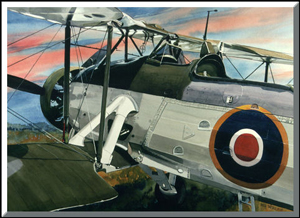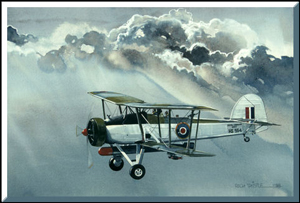Article by Rich Thistle ©
 Bob's Swordfish by Rich Thistle© The hot June sun reigned supreme as I stood on the east end of the grass strip called Camden's airport, three miles south of Stratford. Most Saturdays I would be painting in my air-conditioned studio, but today was special. As the perspiration trickled, tickling like a pesky fly, I stood listening, watching for the memorial flight to make its appearance.
Bob's Swordfish by Rich Thistle© The hot June sun reigned supreme as I stood on the east end of the grass strip called Camden's airport, three miles south of Stratford. Most Saturdays I would be painting in my air-conditioned studio, but today was special. As the perspiration trickled, tickling like a pesky fly, I stood listening, watching for the memorial flight to make its appearance.
On a hot Saturday afternoon in June, 1995, as an exciting part of the three day community event commemorating the fiftieth anniversary of the end of World War II, they had over flown the ceremony at the Stratford cenotaph. Now, as I waited for their arrival, I surveyed the scene with eyes of memory. This was my territory. I grew up here. Here the kid from town rediscovered his rural roots. A few hundred feet south, on the edge of the airport, was the white ranch style house my Dad had built in 1956. Across the corner was the one-room school house, now a tractor dealership, good old Number 5 Downie, where three generations of Thistle's, including me, had studied and played. There was the ditch where I sailed my boats during spring run-off, the bush where I hunted and adventured.
Here, my interest in aviation was born. This little airport formed the center of my young universe. Many of my strongest visual memories converge here: memories of biplanes and the characters who flew them; memories of Jim Camden, my boyhood friend's father, who, with only one leg could drive, swim and fly with the best of them; memories of fly-ins and fly-overs; memories of endless grass cutting on the little Pony tractor; memories merged with dreams.
The drone of aircraft engines interrupted my self-indulgent reverie. My eyes searched the sky as I strained to catch a first glimpse. I thought - as I always do under these circumstances - of the countless military pilots whose very lives often depended on the superior ability to catch early sight of the enemy.
Finally, I spotted them: a finger-four, Harvards of the Canadian Harvard Association, based at Tillsonburg airport, a single yellow Tiger Moth, and bringing up the rear, a large, rather ungainly biplane, in Temperate Sea Scheme (1943) Coastal Command camouflage, which almost seemed to float rather than fly. One of only two flying in the world, this was what I had come to see.
The Fairey Swordfish became a legend during the dark days of World War II. The 'Stringbag', as it is universally known, achieved unexpected fame and glory, serving throughout the War with distinction, despite apparent obsolescence even in 1939. As a torpedo reconnaissance aircraft in the RAF and the Fleet Air Arm (FAA), the Swordfish, with a crew of three, variously armed with bombs or torpedoes and carrying a .303 Lewis Machine gun, was first taken on strength in February, 1936 in a mainly anti-shipping role. The FAA, by War's end, had 25 first-line Swordfish squadrons.
It was during the Norwegian campaign in 1940 that the Stringbag first came into the limelight. That same year, 20 Swordfish virtually crippled the Italian Navy in a torpedo attack on the fleet in Taranto harbor. As an anti-shipping strike aircraft, the Swordfish accounted for more tonnage of enemy ships sunk and damaged than any other British aircraft in the same role.
But it was in crippling the famous German battleship Bismark, thus enabling the Royal Navy to catch and sink the world's most advanced warship, that the Swordfish clinched it's reputation as one of the most dangerous yet anachronistic weapons of World War II. Apparently, according to its crews, the Stringbag flew so slowly that most ship gun crews had major difficulty targeting the big biplane!
 Bob's Swordfish by Rich Thistle© The hot June sun reigned supreme as I stood on the east end of the grass strip called Camden's airport, three miles south of Stratford. Most Saturdays I would be painting in my air-conditioned studio, but today was special. As the perspiration trickled, tickling like a pesky fly, I stood listening, watching for the memorial flight to make its appearance.
Bob's Swordfish by Rich Thistle© The hot June sun reigned supreme as I stood on the east end of the grass strip called Camden's airport, three miles south of Stratford. Most Saturdays I would be painting in my air-conditioned studio, but today was special. As the perspiration trickled, tickling like a pesky fly, I stood listening, watching for the memorial flight to make its appearance. On a hot Saturday afternoon in June, 1995, as an exciting part of the three day community event commemorating the fiftieth anniversary of the end of World War II, they had over flown the ceremony at the Stratford cenotaph. Now, as I waited for their arrival, I surveyed the scene with eyes of memory. This was my territory. I grew up here. Here the kid from town rediscovered his rural roots. A few hundred feet south, on the edge of the airport, was the white ranch style house my Dad had built in 1956. Across the corner was the one-room school house, now a tractor dealership, good old Number 5 Downie, where three generations of Thistle's, including me, had studied and played. There was the ditch where I sailed my boats during spring run-off, the bush where I hunted and adventured.
Here, my interest in aviation was born. This little airport formed the center of my young universe. Many of my strongest visual memories converge here: memories of biplanes and the characters who flew them; memories of Jim Camden, my boyhood friend's father, who, with only one leg could drive, swim and fly with the best of them; memories of fly-ins and fly-overs; memories of endless grass cutting on the little Pony tractor; memories merged with dreams.
The drone of aircraft engines interrupted my self-indulgent reverie. My eyes searched the sky as I strained to catch a first glimpse. I thought - as I always do under these circumstances - of the countless military pilots whose very lives often depended on the superior ability to catch early sight of the enemy.
Finally, I spotted them: a finger-four, Harvards of the Canadian Harvard Association, based at Tillsonburg airport, a single yellow Tiger Moth, and bringing up the rear, a large, rather ungainly biplane, in Temperate Sea Scheme (1943) Coastal Command camouflage, which almost seemed to float rather than fly. One of only two flying in the world, this was what I had come to see.
The Fairey Swordfish became a legend during the dark days of World War II. The 'Stringbag', as it is universally known, achieved unexpected fame and glory, serving throughout the War with distinction, despite apparent obsolescence even in 1939. As a torpedo reconnaissance aircraft in the RAF and the Fleet Air Arm (FAA), the Swordfish, with a crew of three, variously armed with bombs or torpedoes and carrying a .303 Lewis Machine gun, was first taken on strength in February, 1936 in a mainly anti-shipping role. The FAA, by War's end, had 25 first-line Swordfish squadrons.
It was during the Norwegian campaign in 1940 that the Stringbag first came into the limelight. That same year, 20 Swordfish virtually crippled the Italian Navy in a torpedo attack on the fleet in Taranto harbor. As an anti-shipping strike aircraft, the Swordfish accounted for more tonnage of enemy ships sunk and damaged than any other British aircraft in the same role.
But it was in crippling the famous German battleship Bismark, thus enabling the Royal Navy to catch and sink the world's most advanced warship, that the Swordfish clinched it's reputation as one of the most dangerous yet anachronistic weapons of World War II. Apparently, according to its crews, the Stringbag flew so slowly that most ship gun crews had major difficulty targeting the big biplane!
 SWORDFISH PATROL By Rich Thistle©
SWORDFISH PATROL By Rich Thistle©Of the 2399 Swordfish manufactured, some found their way into the RCAF, flying in Eastern Air Command on coastal patrol. One such aircraft, HS554, flew 362 hours during the war on Canada's east coast. Bob Spence, of Muirkirk Ontario, bought his first Swordfish as a sad derelict at the Ernie Simmons estate sale near Tillsonburg, on Labor Day weekend, 1970. Over the next few years, three more Swordfish relics were purchased for parts. Over twenty-one years, Bob, with the help of many friends and volunteers, gradually brought the huge biplane back to life. Using original patterns and materials specified in a 1934 Fairey Aviation list, they pooled their enthusiasm and skill in the reconstruction project.
Containing 60% newly-manufactured parts, Bob's Swordfish first flew on August 17, 1992 with Bob at the controls. Since then, it has become a familiar and popular sight at air shows and events in southern Ontario, recalling the history made by the machine and the men who flew her.
As the Swordfish flew close over my head, I forgot all about the oppressive heat. I thought of Taranto and the Bismark. I thought of landing that big bird on the pitching deck of a small carrier. I thought of the thousands of hours of joy, sweat and tears required to bring her back to life and to Camden's airport that day. As she taxied to a stop before a large crowd of admirers, I felt strong emotion and swelling pride. I felt privileged just to be there. I knew I would have to paint her.
My emotion fuelled me through two paintings of Bob's Swordfish. BOB'S SWORDFISH and SWORDFISH PATROL are both watercolors which have found happy homes.
Containing 60% newly-manufactured parts, Bob's Swordfish first flew on August 17, 1992 with Bob at the controls. Since then, it has become a familiar and popular sight at air shows and events in southern Ontario, recalling the history made by the machine and the men who flew her.
As the Swordfish flew close over my head, I forgot all about the oppressive heat. I thought of Taranto and the Bismark. I thought of landing that big bird on the pitching deck of a small carrier. I thought of the thousands of hours of joy, sweat and tears required to bring her back to life and to Camden's airport that day. As she taxied to a stop before a large crowd of admirers, I felt strong emotion and swelling pride. I felt privileged just to be there. I knew I would have to paint her.
My emotion fuelled me through two paintings of Bob's Swordfish. BOB'S SWORDFISH and SWORDFISH PATROL are both watercolors which have found happy homes.
